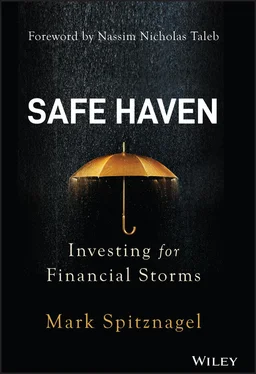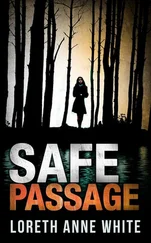So the tools of modern finance helped create a “rent‐seeking” class of people whose interest diverged from those of their clients—and ones who get eventually bailed out by taxpayers.
While the financial rent seekers were clearly the enemies of society, we found actually worse enemies: the imitators.
For, at Universa, Spitz built a structure that tail‐hedged portfolios, hence insulated him from the need for delayed random gratification. As introduced (and formulated ) in Safe Haven , risk mitigation needs to be “cost‐effective” (i.e., it should raise your wealth), and to do that it needs to mitigate the risks that matter, not the risks that don't.
It was the birth of tail risk hedging as an investable asset class. Tail risk hedging removed the effect of the nasty Black Swan on portfolios; cost‐effective tail risk hedging obliterated all the other forms of risk mitigation. Accordingly, the idea grew on people and a new category was born. This led to a legion of imitators—those very same mutua muli persons who had previously been fooled by modern finance tools, finding a new thing to sell.
Universa proved the following: not only is there no substitute to tail risk hedging, but, when it comes to tail risk hedging, simply—as per the boast in the Porsche advertisement—there is no substitute.
For when you go from a principle to execution, things are much more complicated: the output is simple to the outsider, the process is hard seen from the inside. Indeed, it takes years of study and practice, not counting natural edges and understanding of the payoffs and probabilistic mechanisms.
I said earlier that Mark's edge came from pit trading and a natural (noncontrived) understanding of the mathematics of tails. Not quite. His edge has been largely behavioral, and my description of hardheaded was an understatement. Perhaps the most undervalued attribute for humans is dogged, obsessive, boring discipline: in more than two decades, I never saw him once deviate a micro‐inch from a given protocol.
This is his monumental f*** you to the investment industry.
Part One What Comes First

 At War with Luck
At War with Luck
WRITTEN IN BLOOD
In the words of the nineteenth‐century German philosopher Friedrich Nietzsche, thus spoken by his ancient Persian prophet Zarathustra, “Of all that is written, I love only what a person hath written with his blood.”
If so, Nietzsche would have loved this book.
It was written with the blood of war against luck, fought over the last more than a quarter century in my life as a trader. It grew organically out of an investing and risk‐mitigation practice as a hedge fund manager and professional safe haven investor . The message of this book has been and will always be lived by me and my hedge fund firm, Universa Investments. (It is our manifesto.)
Talk is cheap. Ideas and commentary are just that. Significance only comes from the doing, from action within the arena. It is not my business, like Sherlock Holmes, “to know what other people do not know.” It is my business to do what other people do not and cannot do (as well as, just as importantly, to know what I do not know). Doing and demonstrating effective safe haven investing is far, far more important than arguing about what it should be. And even among most of those who claim to do it, they neglect those pithy words from Hemingway to “never confuse movement with action.”
This book tells of the foundation and methodology behind how, as of this writing, Universa risk‐mitigated portfolios have, over their decade‐plus life to date, outperformed the S&P 500 by over 3% on an annualized, net basis. More to the point, this performance is a direct consequence of having far less risk . This level of outperformance is rare in the hedge fund industry and among risk‐mitigation strategies in general, which have pretty much all underperformed the S&P 500 during this and most periods. The markets have been good to us because we haven't tried to cheat them; we haven't tried to predict or outsmart them. We have only aligned our investing, in a focused way, with our beliefs about the way they work.
People think of risk mitigation as a liability, as a tradeoff against wealth creation, because it usually is. Universa is, if nothing else, a real‐life case study and out‐of‐sample test that unequivocally proves the point that risk mitigation doesn't have to be viewed that way. Risk mitigation can and should be thought of as being additive to portfolios over time—with the right risk mitigation, that is.This is the mark that I want Universa to make in the markets.
Writing this book has been a labor of love, though it has had a difficult time competing for my attention, which is consumed by Universa. But the book has provided very important opportunities for introspection. It has also made me think more deeply about questions that I am always asked by people about what small “lay” investors can do to protect their portfolios.
As this book is, in part, a response to those questions, I do want to ensure that expectations are set appropriately at the start. This is not a “how‐to” book, but it is a “why‐to” as well as a “why‐not‐to” book. Let's be clear: What I do specifically as a safe haven investor is not to be attempted by nonprofessionals (nor—perhaps even especially—by most professionals). Nothing that I could tell you in a book will change that.
So, I will not be holding your hand and teaching you how to do it; I will not be revealing much in the way of trade secrets, and I have no interest in selling you anything as an investment manager. This book is not about the workings of a specific safe haven strategy, per se; nor is it an encyclopedic survey of all the major safe haven investments. Moreover, it has little if any current market commentary—as this would be entirely unnecessary to the book's point.
That said, there are big investing problems to be solved, and I do explicitly employ at Universa their conclusive solution that will be found over the course of this book. Surely, that's a good thing. After all, if it's such a great solution, wouldn't it be a big red flag if I didn't put it into practice?
My intention in this book is to present the basic concepts underlying my approach in a straightforward manner. One‐eighth of the iceberg is above water, and that's all we need. (While I am forced into the mathematical weeds at times, believe me, I tried my best to stay out of them.) I offer a logical and practical analytical framework to demystify safe havens, for viewing and thinking about their value in mitigating systematic risk, and what that even means in the first place. That is to say, I offer a framework for rigorously testing hypotheses about safe havens and their very existence.
If the only things readers get out of this book are a more realistic and rational premise of safe haven investing and a foundation from which to assess and tackle it—and thus avoid its traps—then the book will have achieved its purpose. It should help the reader and pay back their expense of buying this book manyfold. You will make money investing and you will lose money investing, but, when you look back at it all, what really will have mattered is getting that foundation right.
Читать дальше


 At War with Luck
At War with Luck










